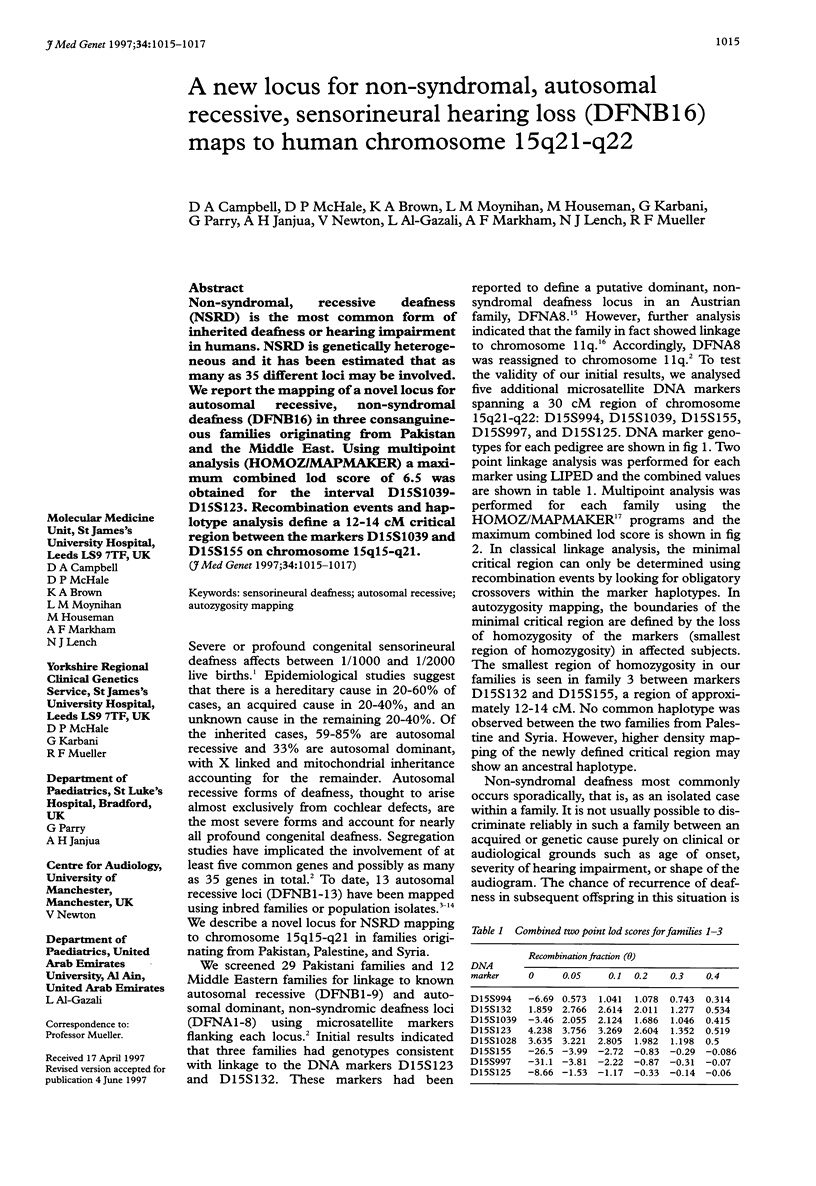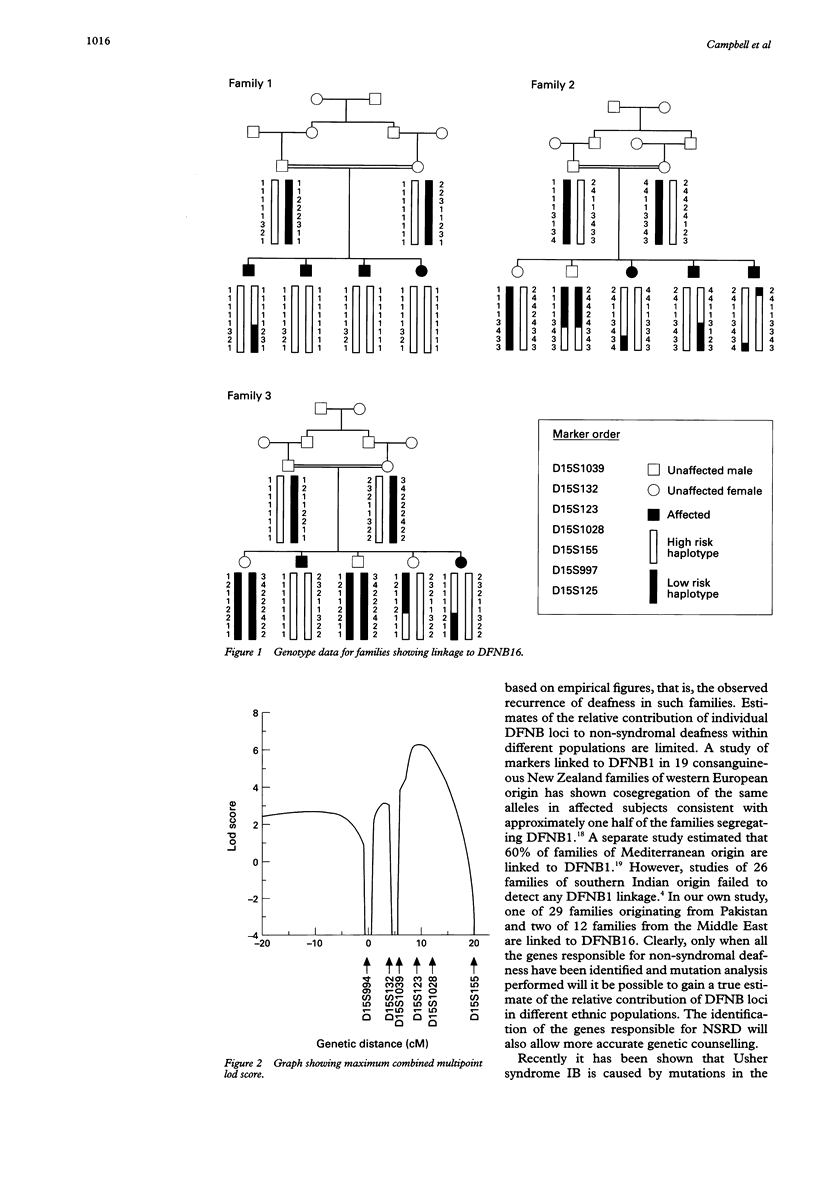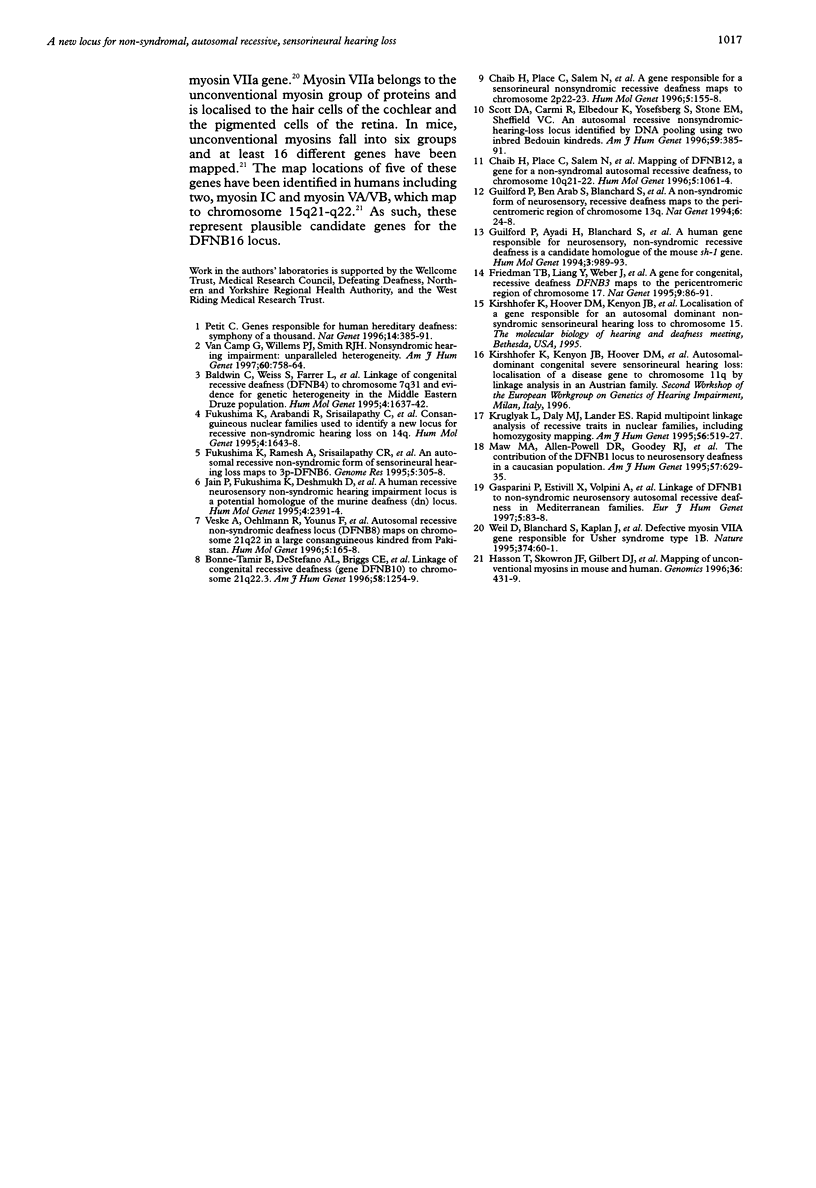Abstract
Non-syndromal, recessive deafness (NSRD) is the most common form of inherited deafness or hearing impairment in humans. NSRD is genetically heterogeneous and it has been estimated that as many as 35 different loci may be involved. We report the mapping of a novel locus for autosomal recessive, non-syndromal deafness (DFNB16) in three consanguineous families originating from Pakistan and the Middle East. Using multipoint analysis (HOMOZ/MAPMAKER) a maximum combined lod score of 6.5 was obtained for the interval D15S1039-D15S123. Recombination events and haplotype analysis define a 12-14 cM critical region between the markers D15S1039 and D15S155 on chromosome 15q15-q21.
Full text
PDF


Selected References
These references are in PubMed. This may not be the complete list of references from this article.
- Baldwin C. T., Weiss S., Farrer L. A., De Stefano A. L., Adair R., Franklyn B., Kidd K. K., Korostishevsky M., Bonné-Tamir B. Linkage of congenital, recessive deafness (DFNB4) to chromosome 7q31 and evidence for genetic heterogeneity in the Middle Eastern Druze population. Hum Mol Genet. 1995 Sep;4(9):1637–1642. doi: 10.1093/hmg/4.9.1637. [DOI] [PubMed] [Google Scholar]
- Bonné-Tamir B., DeStefano A. L., Briggs C. E., Adair R., Franklyn B., Weiss S., Korostishevsky M., Frydman M., Baldwin C. T., Farrer L. A. Linkage of congenital recessive deafness (gene DFNB10) to chromosome 21q22.3. Am J Hum Genet. 1996 Jun;58(6):1254–1259. [PMC free article] [PubMed] [Google Scholar]
- Chaib H., Place C., Salem N., Dodé C., Chardenoux S., Weissenbach J., el Zir E., Loiselet J., Petit C. Mapping of DFNB12, a gene for a non-syndromal autosomal recessive deafness, to chromosome 10q21-22. Hum Mol Genet. 1996 Jul;5(7):1061–1064. doi: 10.1093/hmg/5.7.1061. [DOI] [PubMed] [Google Scholar]
- Chaïb H., Place C., Salem N., Chardenoux S., Vincent C., Weissenbach J., El-Zir E., Loiselet J., Petit C. A gene responsible for a sensorineural nonsyndromic recessive deafness maps to chromosome 2p22-23. Hum Mol Genet. 1996 Jan;5(1):155–158. doi: 10.1093/hmg/5.1.155. [DOI] [PubMed] [Google Scholar]
- Friedman T. B., Liang Y., Weber J. L., Hinnant J. T., Barber T. D., Winata S., Arhya I. N., Asher J. H., Jr A gene for congenital, recessive deafness DFNB3 maps to the pericentromeric region of chromosome 17. Nat Genet. 1995 Jan;9(1):86–91. doi: 10.1038/ng0195-86. [DOI] [PubMed] [Google Scholar]
- Fukushima K., Ramesh A., Srisailapathy C. R., Ni L., Chen A., O'Neill M., Van Camp G., Coucke P., Smith S. D., Kenyon J. B. Consanguineous nuclear families used to identify a new locus for recessive non-syndromic hearing loss on 14q. Hum Mol Genet. 1995 Sep;4(9):1643–1648. doi: 10.1093/hmg/4.9.1643. [DOI] [PubMed] [Google Scholar]
- Fukushima K., Ramesh A., Srisailapathy C. R., Ni L., Wayne S., O'Neill M. E., Van Camp G., Coucke P., Jain P., Wilcox E. R. An autosomal recessive nonsyndromic form of sensorineural hearing loss maps to 3p-DFNB6. Genome Res. 1995 Oct;5(3):305–308. doi: 10.1101/gr.5.3.305. [DOI] [PubMed] [Google Scholar]
- Gasparini P., Estivill X., Volpini V., Totaro A., Castellvi-Bel S., Govea N., Mila M., Della Monica M., Ventruto V., De Benedetto M. Linkage of DFNB1 to non-syndromic neurosensory autosomal-recessive deafness in Mediterranean families. Eur J Hum Genet. 1997 Mar-Apr;5(2):83–88. [PubMed] [Google Scholar]
- Guilford P., Ayadi H., Blanchard S., Chaib H., Le Paslier D., Weissenbach J., Drira M., Petit C. A human gene responsible for neurosensory, non-syndromic recessive deafness is a candidate homologue of the mouse sh-1 gene. Hum Mol Genet. 1994 Jun;3(6):989–993. doi: 10.1093/hmg/3.6.989. [DOI] [PubMed] [Google Scholar]
- Guilford P., Ben Arab S., Blanchard S., Levilliers J., Weissenbach J., Belkahia A., Petit C. A non-syndrome form of neurosensory, recessive deafness maps to the pericentromeric region of chromosome 13q. Nat Genet. 1994 Jan;6(1):24–28. doi: 10.1038/ng0194-24. [DOI] [PubMed] [Google Scholar]
- Hasson T., Skowron J. F., Gilbert D. J., Avraham K. B., Perry W. L., Bement W. M., Anderson B. L., Sherr E. H., Chen Z. Y., Greene L. A. Mapping of unconventional myosins in mouse and human. Genomics. 1996 Sep 15;36(3):431–439. doi: 10.1006/geno.1996.0488. [DOI] [PubMed] [Google Scholar]
- Jain P. K., Fukushima K., Deshmukh D., Ramesh A., Thomas E., Lalwani A. K., Kumar S., Plopis B., Skarka H., Srisailapathy C. R. A human recessive neurosensory nonsyndromic hearing impairment locus is potential homologue of murine deafness (dn) locus. Hum Mol Genet. 1995 Dec;4(12):2391–2394. doi: 10.1093/hmg/4.12.2391. [DOI] [PubMed] [Google Scholar]
- Kruglyak L., Daly M. J., Lander E. S. Rapid multipoint linkage analysis of recessive traits in nuclear families, including homozygosity mapping. Am J Hum Genet. 1995 Feb;56(2):519–527. [PMC free article] [PubMed] [Google Scholar]
- Maw M. A., Allen-Powell D. R., Goodey R. J., Stewart I. A., Nancarrow D. J., Hayward N. K., Gardner R. J. The contribution of the DFNB1 locus to neurosensory deafness in a Caucasian population. Am J Hum Genet. 1995 Sep;57(3):629–635. [PMC free article] [PubMed] [Google Scholar]
- Petit C. Genes responsible for human hereditary deafness: symphony of a thousand. Nat Genet. 1996 Dec;14(4):385–391. doi: 10.1038/ng1296-385. [DOI] [PubMed] [Google Scholar]
- Scott D. A., Carmi R., Elbedour K., Yosefsberg S., Stone E. M., Sheffield V. C. An autosomal recessive nonsyndromic-hearing-loss locus identified by DNA pooling using two inbred Bedouin kindreds. Am J Hum Genet. 1996 Aug;59(2):385–391. [PMC free article] [PubMed] [Google Scholar]
- Van Camp G., Willems P. J., Smith R. J. Nonsyndromic hearing impairment: unparalleled heterogeneity. Am J Hum Genet. 1997 Apr;60(4):758–764. [PMC free article] [PubMed] [Google Scholar]
- Veske A., Oehlmann R., Younus F., Mohyuddin A., Müller-Myhsok B., Mehdi S. Q., Gal A. Autosomal recessive non-syndromic deafness locus (DFNB8) maps on chromosome 21q22 in a large consanguineous kindred from Pakistan. Hum Mol Genet. 1996 Jan;5(1):165–168. doi: 10.1093/hmg/5.1.165. [DOI] [PubMed] [Google Scholar]
- Weil D., Blanchard S., Kaplan J., Guilford P., Gibson F., Walsh J., Mburu P., Varela A., Levilliers J., Weston M. D. Defective myosin VIIA gene responsible for Usher syndrome type 1B. Nature. 1995 Mar 2;374(6517):60–61. doi: 10.1038/374060a0. [DOI] [PubMed] [Google Scholar]


